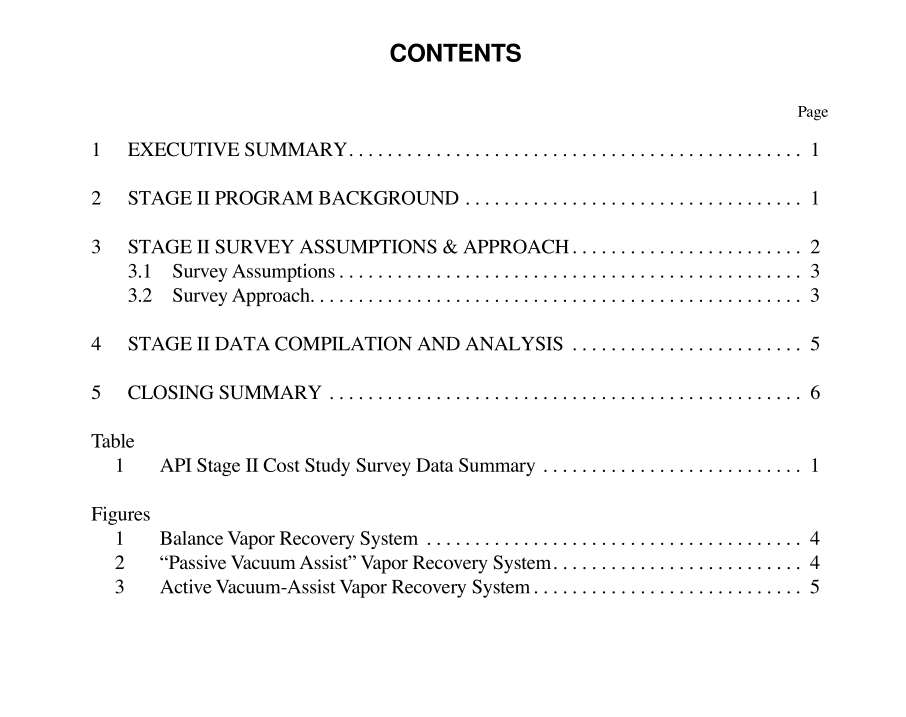API Publ 1645 pdf download

API Publ 1645 pdf download.Stage II Vapor Recovery System Operations & System Installation Costs
1 Executive Summary
Stage II vapor recovery is a well-known air quality control measure that reduces ozone precursors from gasoline dis- pensing facilities (GDFs). As a result of its relative high- visual proÞle, Stage II vapor controls are sometimes proposed as a part of a regional air quality attainment strategy without adequately comparing its overall cost effectiveness to other available control measures. Changes in equipment technol- ogy and system testing techniques continue to raise new issues associated with installing, operating and maintaining compliance of Stage II systems. The purpose of this Stage II costs study partially comes from the U.S. EPAÕs more stringent ozone standard that will bring additional metropolitan areas into non-attainment status. These additional metropolitan non-attainment areas may consider Stage II controls as a priority air quality control measure. As a further consideration, the U.S. EPA has also implemented an on-board refueling vapor recovery (ORVR) requirement for new vehicles. It is designed to capture gasoline vapors at the nozzle/vehicle gas tank interface during refueling. Adding to the complexity of the matter, the California Air Resources Board (CARB), a nationally-recognized lead agency in the certiÞcation of Stage II equipment and systems, has recently promulgated major changes to the California Stage II vapor control program. This is important because many states have linked their Stage II programs to the CARB equipment and system certiÞcation process. However, this paper is focused on the current average cost of installing Stage II vapor controls to meet the requirements of pre-EVR CARB approved systems. This study considered three different types of retail gaso- line outlet (RGO) vapor recovery systems: 1. vapor balance, 2. passive vacuum assist,3. and active vacuum assist. The Òvapor balanceÓ system, conÞgured with a corrugated bellows over the nozzle spout designed for capturing vapor, has been in use since vapor recovery was Þrst required. The system has been reÞned and upgraded with improving technology. A more recent technology initially pioneered in the Midwest is the Òpassive vacuum assistÓ system. Initial versions of this system used reciprocal vacuum pumps for each active nozzle powered by the ßow of gasoline to the vehicle fuel tank. Subse- quent versions of this type of Òdispenser-basedÓ approach use electrical pumps to return the collected vapor back to the gaso- line storage tanks, using electronic signals from the dispenser meters to regulate the vapor pump speed. Finally, the Òactive vacuum assistÓ system has also under- gone many improvements since it was Þrst used. This system maintains a vacuum on the entire Stage II recovery system and processes the excess vapor collected through a central vapor processor or burner. A survey of API members and several other sources of information produced average Stage II installation cost data representing company-speciÞc typical Stage II system conÞg- urations for the three targeted vapor recovery system types. The collected data was adjusted to conform to a consistent refueling system conÞguration that should not be considered typical for the industry. The equipment conÞguration used in this paper were an equalized number of nozzles, hoses, dis- pensers and refueling positions for all three types of vapor recovery systems evaluated. [See Table 1.]
3 Stage II Survey Assumptions & Approach
This study was conceived and scoped to address the Òvapor balanceÓ system and two categories of vacuum-assist sys- tems, ÒactiveÓ and Òpassive.Ó The vapor balance system oper- ates based on the principal of vapor displacement by providing a vapor recovery return line to collect vapors from the vehicle fuel tank pushed out by the incoming liquid gaso- line. It uses the seal between the vehicle being refueled and the faceplate of the fueling nozzle. The vapors then move through a bellows, which surrounds the nozzle, to piping back to the gasoline storage tank. Passive vacuum assist systems may be distinguished from active vacuum assist systems by their dispenser-based approach to vapor recovery. Passive vac-assist stations use ßow controls at the dispenser to return vapor to the gasoline storage tank, whereas active vac-assist systems use a central vacuum unit to recover vapor from the entire system to the tank, pro- cessing excess vapor by incineration or by other means.









